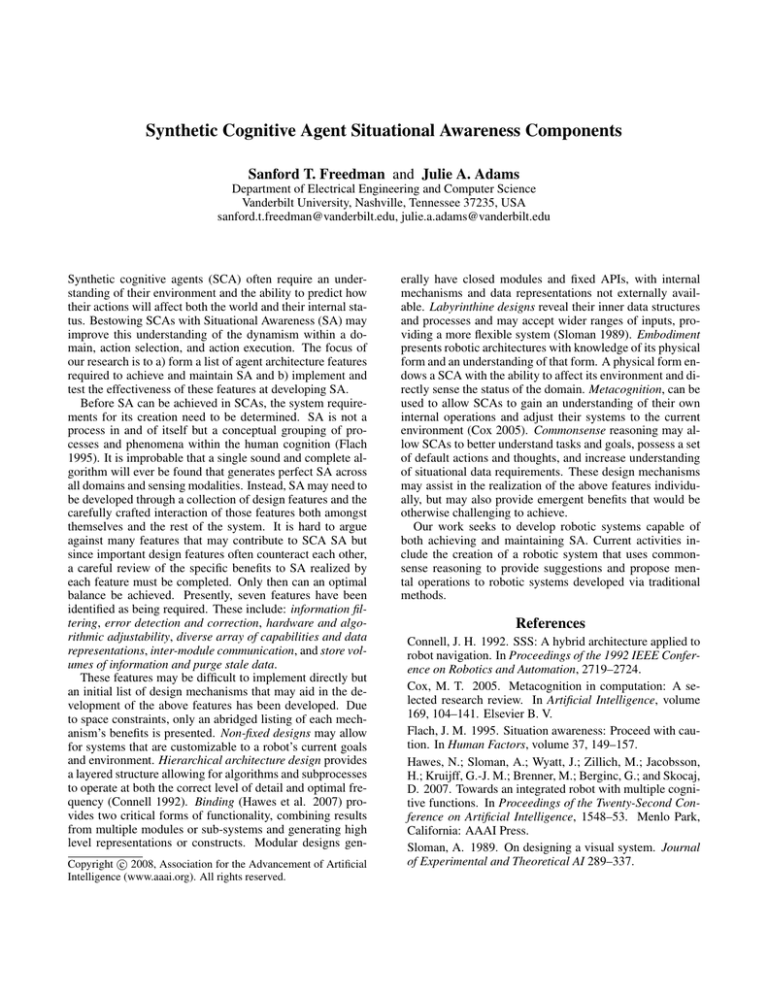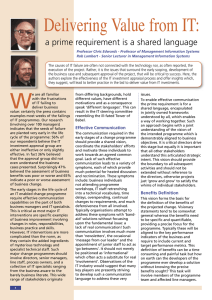
Synthetic Cognitive Agent Situational Awareness Components
Sanford T. Freedman and Julie A. Adams
Department of Electrical Engineering and Computer Science
Vanderbilt University, Nashville, Tennessee 37235, USA
sanford.t.freedman@vanderbilt.edu, julie.a.adams@vanderbilt.edu
Synthetic cognitive agents (SCA) often require an understanding of their environment and the ability to predict how
their actions will affect both the world and their internal status. Bestowing SCAs with Situational Awareness (SA) may
improve this understanding of the dynamism within a domain, action selection, and action execution. The focus of
our research is to a) form a list of agent architecture features
required to achieve and maintain SA and b) implement and
test the effectiveness of these features at developing SA.
Before SA can be achieved in SCAs, the system requirements for its creation need to be determined. SA is not a
process in and of itself but a conceptual grouping of processes and phenomena within the human cognition (Flach
1995). It is improbable that a single sound and complete algorithm will ever be found that generates perfect SA across
all domains and sensing modalities. Instead, SA may need to
be developed through a collection of design features and the
carefully crafted interaction of those features both amongst
themselves and the rest of the system. It is hard to argue
against many features that may contribute to SCA SA but
since important design features often counteract each other,
a careful review of the specific benefits to SA realized by
each feature must be completed. Only then can an optimal
balance be achieved. Presently, seven features have been
identified as being required. These include: information filtering, error detection and correction, hardware and algorithmic adjustability, diverse array of capabilities and data
representations, inter-module communication, and store volumes of information and purge stale data.
These features may be difficult to implement directly but
an initial list of design mechanisms that may aid in the development of the above features has been developed. Due
to space constraints, only an abridged listing of each mechanism’s benefits is presented. Non-fixed designs may allow
for systems that are customizable to a robot’s current goals
and environment. Hierarchical architecture design provides
a layered structure allowing for algorithms and subprocesses
to operate at both the correct level of detail and optimal frequency (Connell 1992). Binding (Hawes et al. 2007) provides two critical forms of functionality, combining results
from multiple modules or sub-systems and generating high
level representations or constructs. Modular designs genc 2008, Association for the Advancement of Artificial
Copyright Intelligence (www.aaai.org). All rights reserved.
erally have closed modules and fixed APIs, with internal
mechanisms and data representations not externally available. Labyrinthine designs reveal their inner data structures
and processes and may accept wider ranges of inputs, providing a more flexible system (Sloman 1989). Embodiment
presents robotic architectures with knowledge of its physical
form and an understanding of that form. A physical form endows a SCA with the ability to affect its environment and directly sense the status of the domain. Metacognition, can be
used to allow SCAs to gain an understanding of their own
internal operations and adjust their systems to the current
environment (Cox 2005). Commonsense reasoning may allow SCAs to better understand tasks and goals, possess a set
of default actions and thoughts, and increase understanding
of situational data requirements. These design mechanisms
may assist in the realization of the above features individually, but may also provide emergent benefits that would be
otherwise challenging to achieve.
Our work seeks to develop robotic systems capable of
both achieving and maintaining SA. Current activities include the creation of a robotic system that uses commonsense reasoning to provide suggestions and propose mental operations to robotic systems developed via traditional
methods.
References
Connell, J. H. 1992. SSS: A hybrid architecture applied to
robot navigation. In Proceedings of the 1992 IEEE Conference on Robotics and Automation, 2719–2724.
Cox, M. T. 2005. Metacognition in computation: A selected research review. In Artificial Intelligence, volume
169, 104–141. Elsevier B. V.
Flach, J. M. 1995. Situation awareness: Proceed with caution. In Human Factors, volume 37, 149–157.
Hawes, N.; Sloman, A.; Wyatt, J.; Zillich, M.; Jacobsson,
H.; Kruijff, G.-J. M.; Brenner, M.; Berginc, G.; and Skocaj,
D. 2007. Towards an integrated robot with multiple cognitive functions. In Proceedings of the Twenty-Second Conference on Artificial Intelligence, 1548–53. Menlo Park,
California: AAAI Press.
Sloman, A. 1989. On designing a visual system. Journal
of Experimental and Theoretical AI 289–337.




